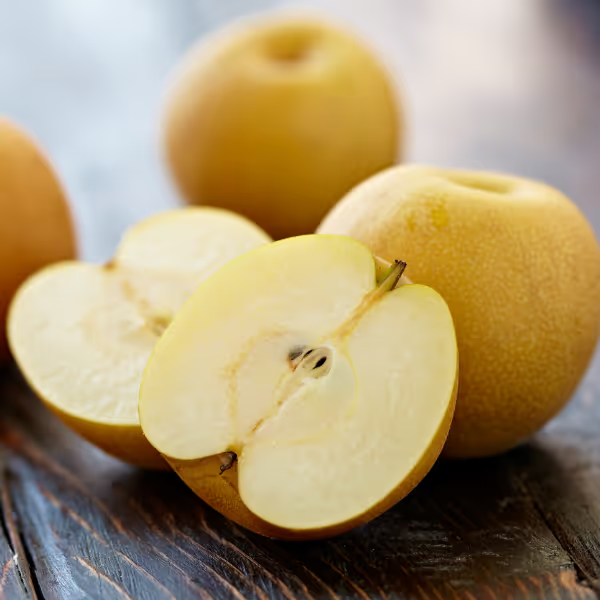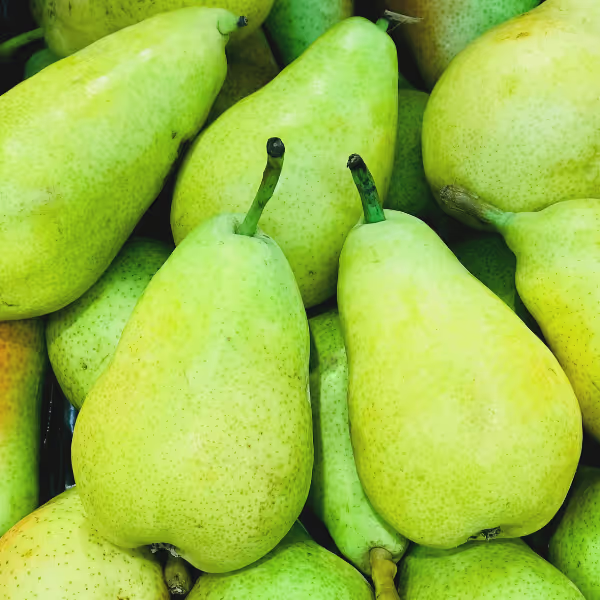What Does it Taste Like?
Pears have a delicate flavor that ranges from floral to honey-like, depending on the variety. Some pears are more crisp and crunchy, like apples, while others are more soft and buttery, like peaches. Pears have a smooth and grainy texture that melts in your mouth. Pears are best eaten when they are ripe, which you can tell by gently pressing the neck of the fruit near the stem. If it yields slightly, it is ready to eat.
Varieties we grow

Asian Pears
Asian pears are a type of fruit that belong to the genus Pyrus, the same as regular pears. However, they have a round shape and a crisp texture, similar to apples. They are also known as apple pears, sand pears, nashi, Japanese pears, Chinese pears, Korean pears, and more. Asian pears have a sweet and juicy flavor that ranges from floral to honey-like, depending on the variety. They can be eaten raw, cooked, or preserved, and they have many health benefits, such as fiber, vitamin C, potassium, copper, and folate.

Bartlett Pears
Bartlet pears are a type of pear that have a sweet and juicy flavor and a smooth and grainy texture. They have a yellow-green or red skin when ripe, and a true pear shape with a rounded bell and a narrow neck. Bartlet pears are the most commonly grown variety of pear in most countries outside Asia, and they are often used for canning, baking, poaching, or making preserves.
Why Should I Eat It?
Pears are not only tasty, but also healthy. They are low in calories, high in fiber, and rich in antioxidants, such as vitamin C. Pears can help support your immune system, lower your cholesterol, and regulate your blood sugar. Pears also contain potassium, which is essential for muscle and nerve function, and copper, which is important for connective tissue and brain health. One medium pear provides about 100 calories, 6 grams of fiber, 8 milligrams of vitamin C, 206 milligrams of potassium, and 0.3 milligrams of copper.
Pears

August - November
When you think of fall, you might think of pumpkins, apples, and cinnamon. But there is another fruit that deserves your attention: pears. Pears are juicy, sweet, and versatile, and they can add a touch of elegance to any dish. Whether you enjoy them fresh, cooked, or preserved, pears are a delicious way to celebrate the season.
Recommended Storage
How Do I Store It?
Short Term
How you store your pears depends on how ripe they are.
If your pears are underripe, then it's best to store them on the counter at room temperature until they've ripened. To test if a pear is ripe, apply gentle pressure near the stem end. If it gives slightly, it's ready to eat.
If your pears are ripened. then you'll want to store them in the fridge. Place the pears inside of a paper bag then store in the crisper drawer of your fridge for up to 12 days.
Long Term
- Freezing: To freeze pears, cut them into halves, quarters, or slices and soak them in 1 quart of water and 3 tablespoons of lemon juice for 3 to 5 minutes. This will prevent them from browning. Then, drain and pat them dry and seal them in freezer bags or containers. This will keep them fresh for up to 10 to 12 months. You can also use the pears to make pear butter, which can be frozen in small containers for up to 6 months.
- Pickling: To pickle pears, peel, core, and slice them and pack them in jars with a spiced brine. Process them in a boiling water bath for 10 minutes. This will keep them fresh for up to a year.
- Canning: To can pears, peel, core, and slice them and pack them in jars with water, sugar, and lemon juice. Process them in a boiling water bath for 20 to 25 minutes. This will keep them fresh for up to a year. You can also can pear butter, though I find that the amount of lemon juice needed to safely can them diminished the deep, caramlized flavor of the pear butter.
- Dehydrating: To dry pears, peel, core, and slice them and dip them in lemon juice. Arrange them in a single layer on a baking sheet and bake them in a low oven for 6 to 8 hours, or use a dehydrator. This will keep them fresh for up to 24 months.
How Do I Cook It?
- Poaching: Poaching is a gentle way of cooking pears in a liquid, such as water, wine, juice, or syrup. Poaching enhances the flavor and texture of pears, making them soft, tender, and juicy. Poaching also allows you to infuse pears with different spices, herbs, or citrus zest for extra flavor. Poached pears can be served warm or cold, with whipped cream, ice cream, yogurt, or custard. To poach pears, peel them and cut them in half, then simmer them in a saucepan with your choice of liquid and flavorings until they are easily pierced with a knife.
- Baking: Baking is a simple and delicious way of cooking pears in the oven, either whole or cut into halves or slices. Baking brings out the natural sweetness and aroma of pears, and creates a caramelized crust on the surface. Baking also allows you to stuff pears with nuts, cheese, chocolate, or dried fruits for a decadent treat. Baked pears can be served hot or cold, with honey, maple syrup, caramel sauce, or whipped cream. To bake pears, wash them and leave the peel on, then cut them in half and remove the core. Sprinkle them with ground cloves, cinnamon, and brown sugar, and bake them in a baking dish at 350°F for 25 to 30 minutes, or until they are soft and golden.
- Grilling: Grilling is a fast and easy way of cooking pears on an outdoor grill, either whole or cut into wedges or slices. Grilling adds a smoky flavor and charred marks to pears, and makes them warm and juicy. Grilling also allows you to brush pears with butter, oil, honey, or balsamic vinegar for a savory or sweet glaze. Grilled pears can be served as a side dish, a salad topping, or a dessert, with cheese, nuts, mint, or vanilla ice cream. To grill pears, wash them and leave the peel on, then cut them into wedges or slices and remove the core. Brush them with your choice of glaze and grill them over medium heat for 10 to 15 minutes, turning occasionally, until they are tender and charred.
.avif)
What Goes Well With It?
Pears are versatile and can complement many flavors. Here are some of the best flavor pairings for pears:
- Cheese: Pears and cheese are a classic combination that can be served as an appetizer, snack, or dessert. Try pears with blue cheese, brie, goat cheese, or cheddar for a contrast of sweet and salty.
- Nuts: Pears and nuts add crunch and texture to any dish. Try pears with walnuts, almonds, pecans, or pistachios for a boost of protein and healthy fats.
- Spices: Pears and spices create a warm and cozy flavor that is perfect for fall. Try pears with cinnamon, nutmeg, ginger, cardamom, or cloves for a hint of spice.
- Wine: Pears and wine are a sophisticated and elegant pairing that can elevate any meal. Try pears with white wine, such as riesling, chardonnay, or pinot grigio, or red wine, such as merlot, cabernet sauvignon, or zinfandel, for a balance of acidity and sweetness.
- Honey: Pears and honey are a natural and simple pairing that can sweeten any dish. Try pears with honey for a drizzle of golden goodness.
- Lemon: Pears and lemon are a refreshing and bright pairing that can add a burst of citrus to any dish. Try pears with lemon for a splash of tartness and vitamin C.
- Caramel: Pears and caramel are a decadent and indulgent pairing that can satisfy any sweet tooth. Try pears with caramel for a rich and gooey treat.
- Chocolate: Pears and chocolate are a luxurious and irresistible pairing that can make any occasion special. Try pears with dark chocolate, milk chocolate, or white chocolate for a melt-in-your-mouth delight.
- Vanilla: Pears and vanilla are a subtle and smooth pairing that can enhance any dish. Try pears with vanilla for a touch of creaminess and aroma.
- Ginger: Pears and ginger are a zesty and spicy pairing that can add some heat to any dish. Try pears with ginger for a kick of flavor and anti-inflammatory benefits.
